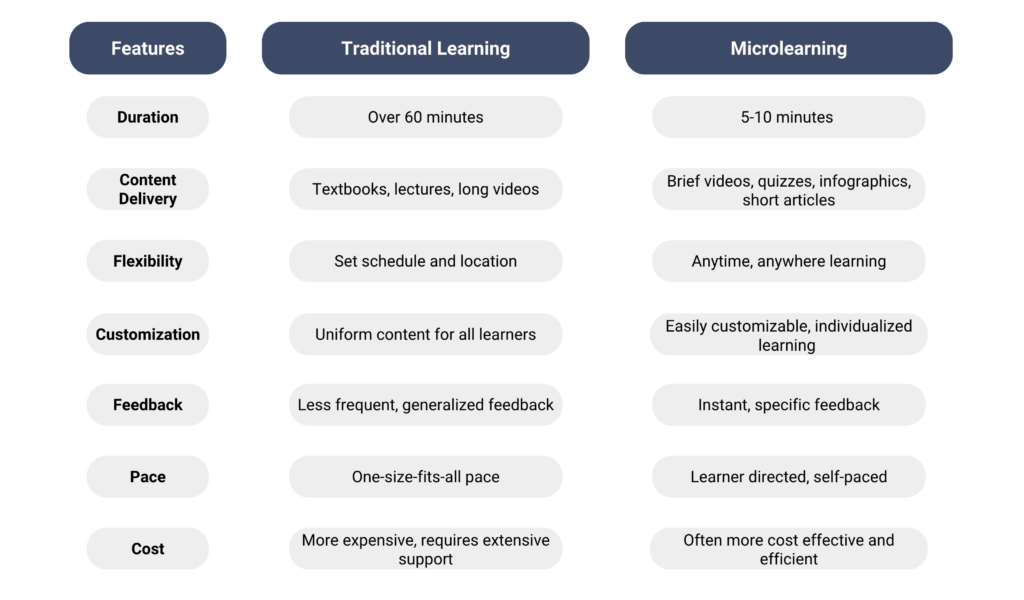In today’s fast-paced world, keeping up with a rapidly changing landscape is crucial to stay ahead of the competition. Incredible technological advancements have transformed how we work and learn, paving the way for an innovative solution – microlearning.
But what is microlearning exactly? How does it differ from traditional learning? In this blog, we’ll take a look at both learning approaches, so you can make an informed choice for your organization’s training needs.
What is traditional learning?
Traditional learning is no stranger to most of us. It’s served as the cornerstone of education and instruction for generations. Traditional learning typically involves teaching a subject through structured classes, lectures, and textbooks – usually in a live, in-person setting.
The core of traditional learning is long-term information retention and understanding of complex ideas and concepts. It can take months or years to master a topic with traditional learning.
However, traditional learning has evolved in the digital age and found its space online. Organizations, educational institutions, and universities alike have transitioned towards online courses, offering employees a more convenient way to learn. But the essence of traditional learning remains unchanged – it still revolves around lectures, textbooks, and examinations.
What is microlearning?
Microlearning is a modern approach to instruction that focuses on short bursts of learning. Instead of tackling complex topics in depth over time, microlearning delivers bite-sized pieces of information quickly and efficiently.
Microlearning is versatile and can be executed either remotely using digital devices or just with pen and paper. It includes various forms of media, like videos, podcasts, and short quizzes, to aid employees in comprehending and retaining the material better. In particular, microlearning emphasizes practice and repetition, making it a useful strategy for enhancing employee training programs.
To illustrate, consider an organization familiarizing its workforce with a new software tool. Employees are introduced to microlearning modules across several days, allowing them to learn each feature of the tool separately and at their own pace – instead of getting lost in a marathon seminar.
Microlearning vs. traditional learning: What’s the difference?

By now, we have a solid grasp of ‘what is traditional learning’ and ‘what is microlearning.’ But what sets them apart from each other?
To help your decision-making process, we’ve put together a simple comparison below, spotlighting the key differences between microlearning and traditional learning.
We’ve also dug a little deeper into the top four features that we hear questions about the most.
Flexibility
Microlearning offers superior flexibility compared to traditional learning. With bite-sized information and activities, employees can learn at their own pace, on their own schedule, without the need for lengthy classroom lectures.
Customization
Microlearning offers significantly more customization than traditional learning. Traditional learning follows a uniform approach to instruction. Employees are expected to conform to the content and instruction that have been set in stone, regardless of their individual needs.
With microlearning, you can tailor content to different employees’ needs and preferences. As a result, employees benefit from a bespoke experience that renders learning more effective and enjoyable.
Pace
Consider the fact that the average employee only has 24 minutes a week to dedicate to learning. This time constraint further complicates traditional learning methods, which typically impose a one-size-fits-all pace on all employees. This can leave some employees struggling to keep up due to diverse job roles and experiences, while others may feel unchallenged and disengaged.
On the other hand, microlearning places the reins of learning speed into the hands of the employee. With self-paced modules, each individual can progress at a pace that is comfortable for them. This ensures a more personalized and stress-free learning experience that can significantly boost both engagement and knowledge retention.
Cost
Traditional learning can demand significant investments such as instructor time, venue rental fees, and training materials.
In contrast, microlearning is considerably less expensive. Since modules are typically created using existing in-house resources and expertise, the need for external trainers and additional material expenses
Moreover, employees can access these modules whenever they’re ready to learn, enabling training without having to take time off work and resulting in indirect savings.

